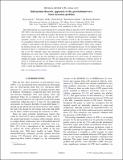| dc.contributor.author | Katsavounidis, Erik | |
| dc.contributor.author | Robinet, Florent | |
| dc.contributor.author | Lynch, Ryan Christopher | |
| dc.contributor.author | Vitale, Salvatore | |
| dc.contributor.author | Essick, Reed Clasey | |
| dc.date.accessioned | 2017-06-26T13:08:14Z | |
| dc.date.available | 2017-06-26T13:08:14Z | |
| dc.date.issued | 2017-05 | |
| dc.date.submitted | 2017-02 | |
| dc.identifier.issn | 2470-0010 | |
| dc.identifier.issn | 2470-0029 | |
| dc.identifier.uri | http://hdl.handle.net/1721.1/110248 | |
| dc.description.abstract | The observational era of gravitational-wave astronomy began in the fall of 2015 with the detection of GW150914. One potential type of detectable gravitational wave is short-duration gravitational-wave bursts, whose waveforms can be difficult to predict. We present the framework for a detection algorithm for such burst events—oLIB—that can be used in low latency to identify gravitational-wave transients. This algorithm consists of (1) an excess-power event generator based on the Q transform—Omicron—, (2) coincidence of these events across a detector network, and (3) an analysis of the coincident events using a Markov chain Monte Carlo Bayesian evidence calculator—LALInferenceBurst. These steps compress the full data streams into a set of Bayes factors for each event. Through this process, we use elements from information theory to minimize the amount of information regarding the signal-versus-noise hypothesis that is lost. We optimally extract this information using a likelihood-ratio test to estimate a detection significance for each event. Using representative archival LIGO data across different burst waveform morphologies, we show that the algorithm can detect gravitational-wave burst events of astrophysical strength in realistic instrumental noise. We also demonstrate that the combination of Bayes factors by means of a likelihood-ratio test can improve the detection efficiency of a gravitational-wave burst search. Finally, we show that oLIB’s performance is robust against the choice of gravitational-wave populations used to model the likelihood-ratio test likelihoods. | en_US |
| dc.description.sponsorship | National Science Foundation (U.S.) | en_US |
| dc.description.sponsorship | Laser Interferometer Gravitational Wave Observatory | en_US |
| dc.description.sponsorship | Centre national de la recherche scientifique (France) | en_US |
| dc.description.sponsorship | Laser Interferometer Gravitational Wave Observatory (agreement PHY-0757058) | en_US |
| dc.publisher | American Physical Society | en_US |
| dc.relation.isversionof | http://dx.doi.org/10.1103/PhysRevD.95.104046 | en_US |
| dc.rights | Article is made available in accordance with the publisher's policy and may be subject to US copyright law. Please refer to the publisher's site for terms of use. | en_US |
| dc.source | American Physical Society | en_US |
| dc.title | Information-theoretic approach to the gravitational-wave burst detection problem | en_US |
| dc.type | Article | en_US |
| dc.identifier.citation | Lynch, Ryan, Salvatore Vitale, Reed Essick, Erik Katsavounidis, and Florent Robinet. “Information-Theoretic Approach to the Gravitational-Wave Burst Detection Problem.” Physical Review D 95, no. 10 (May 30, 2017). | en_US |
| dc.contributor.department | Massachusetts Institute of Technology. Department of Physics | en_US |
| dc.contributor.department | MIT Kavli Institute for Astrophysics and Space Research | en_US |
| dc.audience.educationlevel | | |
| dc.contributor.mitauthor | Lynch, Ryan Christopher | |
| dc.contributor.mitauthor | Vitale, Salvatore | |
| dc.contributor.mitauthor | Essick, Reed Clasey | |
| dc.relation.journal | Physical Review D | en_US |
| dc.eprint.version | Final published version | en_US |
| dc.type.uri | http://purl.org/eprint/type/JournalArticle | en_US |
| eprint.status | http://purl.org/eprint/status/PeerReviewed | en_US |
| dc.date.updated | 2017-06-02T16:41:18Z | |
| dc.language.rfc3066 | en | |
| dc.rights.holder | American Physical Society | |
| dspace.orderedauthors | Lynch, Ryan; Vitale, Salvatore; Essick, Reed; Katsavounidis, Erik; Robinet, Florent | en_US |
| dspace.embargo.terms | N | en_US |
| dc.identifier.orcid | https://orcid.org/0000-0002-5163-683X | |
| dc.identifier.orcid | https://orcid.org/0000-0003-2700-0767 | |
| dc.identifier.orcid | https://orcid.org/0000-0001-8196-9267 | |
| mit.license | PUBLISHER_POLICY | en_US |
